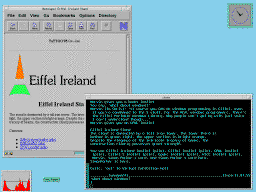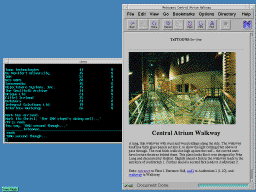


LEICESTER, UNITED KINGDOM - Trade Exhibitions are always the same. Rows upon rows of stands. Carrier bags and balloons. Expensive beer and stale sandwiches. And lots of walking around. Always the same until now, that is.
In early January 1995, we teamed up with IBM to stage the world's first Online Virtual Trade Exhibition. The event, known as TaTTOO'95 Online, was run in conjunction with TaTTOO'95, the annual real-life (RL) conference on Object Technology Transfer held at De Montfort University's, campus in Leicester, England. IBM, provider of the host computer and network connection at their site in Portsmouth, England, supported TaTTOO'95 Online.
There were a number of reasons for organizing a virtual trade exhibition. The real-life (RL) TaTTOO'95 conference features a modest exibition space, usually attracting book publishers and object-oriented (OO) technology specialists. We knew that some exhibitors were finding it increasingly difficult to justify time away from base and the costs incurred in travelling to conferences to participate in exhibitions. By creating an event to which anyone could "travel" on the Internet, we would not only remove some of these constraints, but would actually make it possible for vendors who wouldn't have even considered the RL event to be involved (for instance, we had inquiries from as far away as Australia).
Finally, another good reason for organizing a trade show in cyberspace was that it had never been done before. Although some companies (including Microsoft) have experimented with disk-based events along these lines, this would be the first interactive, real-time trade exhibition to take place on the Internet.
In order to make TaTTOO'95 Online happen, we combined two popular Internet technologies: MUD and WWW.
A number of (paying) exhibitors were provided with customized stands in a virtual exhibition hall, with company representatives logging in over the Internet to staff the stands. In addition to being able to chat to potential customers in real-time, exhibitors were also provided with a never-ending supply of leaflets and brochures created from product and company information they had supplied. The exhibitors gave out leaflets, as well as business cards, to any visitors to the stands.
Of course, it's all very well setting up a trade show on the Global Village Green, but in reality, Internet users inhabit a number of different time-zones. To help overcome this problem, each exhibitor was given a customized "robot" programmed to be able to answer simple queries from delegates and to give out appropriate leaflets, even in the absence of any "real" exhibitor on the stand. In this way, the stands in the exhibition hall were effectively staffed 24 hours a day.
Exhibitors included professional organizations like the British Computer Society's OOPS group; Irish OO specialists IONA technologies; Ubique -- who themselves are working in the field of network-based events and WWW-integration; and of course IBM, whose stand featured a large range of information on programming products such as VisualAge and IBM COBOL. DMU also had a stall manned by volunteers (and a robot) to give information on academic courses and consultancy services.
Running totals were maintained for the number of different delegates who visited each stand in the MOO. Although at the end of the three-day exhibition IBM had the highest score (with DMU coming a close second), all the exhibitors benefitted from the online nature of the event, since they were all provided with a list of names and e-mail addresses of everyone who had visited them, in much the same way that RL exhibitors collect visitors' business cards in a box.
About 200 Internet users registered as "virtual delegates" which not only gave them access to the interactive real-time environment of the MOO, but also provided a personal, customised World-Wide Web page which automatically showed text and graphics of any brochures, along with leaflets and business cards they had collected during the exhibition. When the event had finished, these documents were automatically sent to the delegates by e-mail.
As an experiment, we built a "virtual Queens Building" inside the MOO. The rooms within the virtual world had a one-to-one correspondence with those in the real Queens building, so that anyone familiar with the building would already know their way around inside the MOO. Conversely, and perhaps more interestingly, was the potential for outside visitors (such as delegates of the TaTTOO'95 RL conference) coming to the DMU campus for the first time to visit the virtual Queens Building before leaving home, to give them some idea of its layout. A number of photographs of the real Queens Building were taken, and these were scanned in and placed online so that anyone browsing the event on the World-Wide Web could also take a "tour" of this fascinating building simply by pointing and clicking.
The virtual Queens Building could be seen as an extension of an existing project: the widely-acclaimed "Walk Around Leicester" which includes pictures and descriptions of major landmarks and features in the city. This virtual city tour, which has been accessible on the World-Wide Web for a number of months, allowed TaTTOO delegates to discover items of interest, places to shop, or just how to get to the DMU campus from the railway station, all before they arrived.
This is just one example of how the real and virtual worlds can be brought together using networking technology. The RL conference gained from the online presence of the virtual delegates, while the virtual conference welcomed the additional views of the RL delegates sitting in the Queens Building. A number of journalists were also present at the debate, trading the time and trouble of traveling in the physical world for the relative ease of dialing up the Internet.
However, these events don't all have to be commercial. The MOO objects which were coded to help exhibitors to promote their products might just as easily be used by academics to inform each other of on-going research projects or papers. For example, BioMOO -- a virtual world used by Biology researchers -- already includes a "virtual poster session" which runs 24 hours a day on the World-Wide Web.
At De Montfort University we have been running a research-oriented MOO, known as DMUMOO, since October 1993. This is used as a virtual meeting place for a number of researchers distributed across the globe, as well as for various experiments, including a virtual conference held by the UK Virtual Reality Special Interest Group (UK VR-SIG) in May 1994. Another project, this time in the USA, aims to create MOO robots (aka "MOObots") which are intelligent and can actually hold conversations with the real users. Some of the best known MOO-users are MIT Media Lab and Xerox PARC (where the software originated). An increasing number of researchers are turning to MUD technology to free them from some of the constraints of reduced funding: meeting online rather than face-to-face saves time and money.
The possibilities for the future are very exciting. For example, instead of an exhibition, this could have been a 'market' with people sending encrypted credit card details over the Net and actually buying goods right there and then. Since this is an interactive medium, it would even be possible to haggle the price. Users have been accessing company and product information on the World-Wide Web for some time, but in the Virtual Exhibition the delegates could really talk to the company representatives on the stands, which both sides find useful and important.
With this increasing commercial and academic interest in (and dependence on) the Internet, we can be sure of some interesting developments in the coming year. But you'll have to bring your own beer and sandwiches. ¤
Chris Hand and Mark Skipper are with the Department of Computer Science, De Montfort University, Leicester, UK.
Copyright © 1995 by Chris Hand and Mark Skipper. All rights reserved.